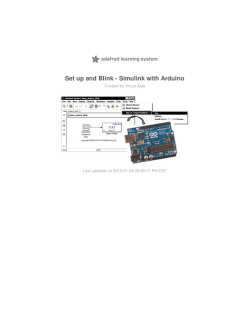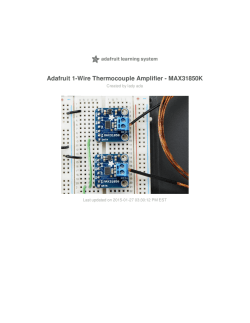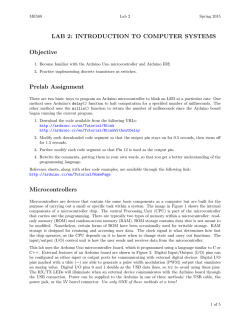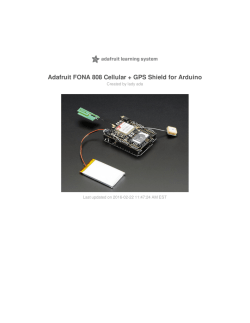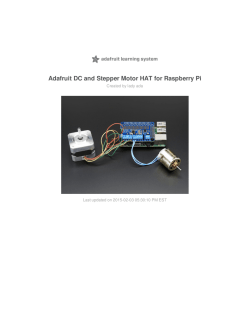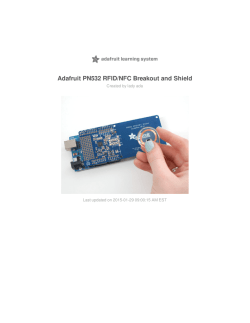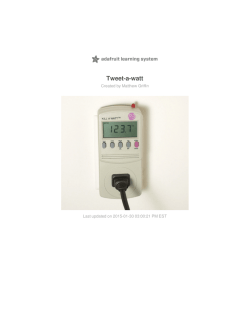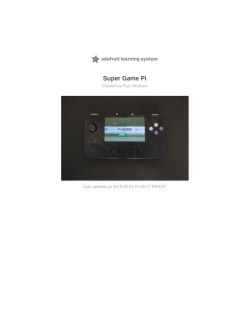
Download PDF - Adafruit Learning System
Set up and Blink - MATLAB and Simulink with Arduino Created by Anuja Apte Last updated on 2015-01-30 04:45:14 PM EST Guide Contents Guide Contents 2 Overview 3 Parts and Software 4 Build the circuit 5 Set up MATLAB and Simulink support package for Arduino Due 7 Set up compiler support 10 Simulink model 11 Generate code, Load and Run 13 Resources 15 © Adafruit Industries https://learn.adafruit.com/how-to-use-matlab-and-simulink-witharduino Page 2 of 16 Overview MATLAB Support Package for Arduino enables you to use MATLAB to communicate with the Arduino board over a USB cable. Simulink Support Package for Arduino enables you to convert your Simulink models to code that runs on the Arduino board (in a click of a button). This tutorial covers a step-by-step guide to: MATLAB Support Package 1. Set up the MATLAB support package for Arduino 2. Send commands from MATLAB to Arduino to blink an LED Simulink Support Package 1. Set up the Simulink support package for Arduino 2. Build a simple Simulink model for controlling pins on the Arduino 3. Generate, download and run code on the Arduino to blink an LED This is the first tutorial in a series on using MATLAB and Simulink to program an Arduino. In this tutorial Arduino Due is used as an example, however the same steps can be used for other boards like Uno, Mega 2560 etc. © Adafruit Industries https://learn.adafruit.com/how-to-use-matlab-and-simulink-witharduino Page 3 of 16 Parts and Software So ftware MATLAB and Simulink Student Suite Release 2014a - now available for 99 $ MathWorks (http://adafru.it/d5E) Amazon US (http://adafru.it/eoc) Amazon UK (http://adafru.it/eod) If you are not a student, you can purchase the MATLAB Home-Use license: MATLAB home-use (http://adafru.it/eoe) Hardware 1. 2. 3. 4. 5. 6. Small breadboard (http://adafru.it/64) 220 Ohm resistor LED (http://adafru.it/845) Connecting wires (http://adafru.it/153) Arduino Due (http://adafru.it/50) USB cable (http://adafru.it/2008) © Adafruit Industries https://learn.adafruit.com/how-to-use-matlab-and-simulink-witharduino Page 4 of 16 Build the circuit Circuit Use the following image to build a simple circuit that connects an LED to pin 9 of Arduino Due. Co nnect the hardware Using the USB connector, connect Arduino Due to the computer that has a MATLAB & Simulink installation. © Adafruit Industries https://learn.adafruit.com/how-to-use-matlab-and-simulink-witharduino Page 5 of 16 © Adafruit Industries https://learn.adafruit.com/how-to-use-matlab-and-simulink-witharduino Page 6 of 16 Set up MATLAB and Simulink support package for Arduino Due Start MATLAB Open MATLAB and click the Add-Ons drop down menu on the top right Start Suppo rt Package Installer Click on Get Hardware Support Packages in the drop down menu to start the installer. Select 'Internet' as a source for installing the support package Select Arduino fro m a list o f suppo rt packages Click Next to see a list of support packages and select Arduino from the list for MATLAB Support Package and Arduino Due for the Simulink Support Package. © Adafruit Industries https://learn.adafruit.com/how-to-use-matlab-and-simulink-witharduino Page 7 of 16 MathWo rks Acco unt Click next and log in to your MathWorks account. If you don't have a MathWorks account, you can create one during the install process or by visiting this page on the MathWorks website (http://adafru.it/eoA). (http://adafru.it/d5K) © Adafruit Industries https://learn.adafruit.com/how-to-use-matlab-and-simulink-witharduino Page 8 of 16 Co ntinue and Co mplete the Installatio n Accept the license agreement on the next screen and click Next through the following screens to finish the installation for both MATLAB and Simulink Support Package for Arduino. © Adafruit Industries https://learn.adafruit.com/how-to-use-matlab-and-simulink-witharduino Page 9 of 16 Set up compiler support Install a suppo rted co mpiler Simulink support package for Arduino is supported on 32-bit and 64-bit Microsoft Windows and Mac OS X. For the code generation process to work, a supported compiler installation is required. Refer to the following page on MathWorks website for a list of supported compilers on Windows and Mac OS: List of supported compilers (http://adafru.it/eof) For example, you can download a Simulink supported compiler from the Microsoft website (http://adafru.it/d5J) for free. Co mpiler set up in MATLAB Enter mex -setup at the MATLAB command prompt to start the compiler set up. When the compiler set up is complete, you should see on MATLAB Command Window the compiler being used. © Adafruit Industries https://learn.adafruit.com/how-to-use-matlab-and-simulink-witharduino Page 10 of 16 Simulink model Open a Simulink demo mo del Enter arduinodue_gettingstarted at the MATLAB Command Window to open a demo model. Again, in this tutorial Arduino Due is used as an example but the same steps can be used for other boards like Uno, Mega 2560 etc. Double-click the Pulse Generator block to explore its pre-configured parameters. The Digital Output block is set up to send the output of the Pulse Generator to pin 9 of the Arduino Due. Double-click the block to explore its pre-configured parameters. You are now ready to program Arduino boards! Optio nal - Create the mo del o n yo ur o wn Click on the Simulink Library icon to open the Simulink library browser In the left navigation pane, select Simulink Support Package for Arduino Hardware On the right navigation pane, double-click the [Examples] block to open the documentation © Adafruit Industries https://learn.adafruit.com/how-to-use-matlab-and-simulink-witharduino Page 11 of 16 Open step-by-step guide Click 'Getting started with Arduino Due Hardware' in the list of demos to open the step-bystep guide to build this model on your own. © Adafruit Industries https://learn.adafruit.com/how-to-use-matlab-and-simulink-witharduino Page 12 of 16 Generate code, Load and Run If you opened the demo model, you can go straight to Run the model on Arduino section. If you followed the steps to create your own model, then to configure the model for Arduino boards follow this section. Prepare the mo del to run o n Arduino bo ards Connect the Arduino board to your computer with a USB cable Select To o ls > Run o n Target Hardware > Prepare to Run... Review the parameters in the dialog that opens Unless already set, set the Target hardware parameter to the Arduino board being used (Arduino Due here) Do not change any other settings Click OK Save the model Run the mo del o n Arduino Click on the 'Deploy to Hardware' button as shown in the figure below You should see the LED on Pin 9 blinking © Adafruit Industries https://learn.adafruit.com/how-to-use-matlab-and-simulink-witharduino Page 13 of 16 © Adafruit Industries https://learn.adafruit.com/how-to-use-matlab-and-simulink-witharduino Page 14 of 16 Resources Examples fo r getting started MATLAB examples (http://adafru.it/d5M) Simulink (http://adafru.it/d5L)examples (http://adafru.it/d5L) Open Examples fo r the Suppo rt Package Full tuto rials MATLAB Getting Started Tutorial (http://adafru.it/d5N) (3 hrs 15 mins) © Adafruit Industries https://learn.adafruit.com/how-to-use-matlab-and-simulink-witharduino Page 15 of 16 Simulink Getting Started Tutorial (http://adafru.it/d5N) (2 hrs 15 mins - 10 mins per module) © Adafruit Industries Last Updated: 2015-01-30 04:45:15 PM EST Page 16 of 16
© Copyright 2025
